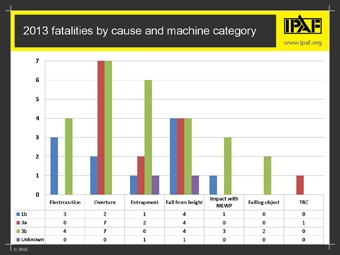The powered access industry is reporting more accidents through IPAF’s voluntary program. This reveals that there were fifty-three fatalities worldwide in 2013 involving aerial work platforms (AWPs), also known as mobile elevating work platforms (MEWPs), according to preliminary results from IPAF’s accident database.
The main causes of these fatalities were: overturn (16), fall from height (13), entrapment (10), electrocution (7), impact with AWP (4) and falling object (2). In one case, the cause of the fatality was not known.
Almost half of the number of reported fatalities (26 or 49 percent) involved mobile booms (3b). Fourteen fatalities (26 percent) involved mobile verticals (3a) and 11 (21 percent) involved static booms (1b). In two cases (4 percent), the type of machine involved was not known.
Thirty (57 percent) of the fatalities occurred in the USA, home of 54 percent of the world’s rental fleet*. Three fatalities each were reported in Germany, Spain and the UK, two fatalities each in Belgium, Canada, France and the Netherlands, and one each in Armenia, Australia, Ireland, Malaysia, Norway and in the Middle East.
IPAF’s accident reporting project was launched in January 2012 and has filled a gap where there was previously no single mechanism for reporting and analysing serious accidents involving AWPs/ MEWPs and no definitive data on the number and main causes of fatal accidents. In the first year of the project, thirty-two fatalities worldwide involving AWPs/ MEWPs were reported.
IPAF technical officer Chris Wraith stressed that the accident project is still in an early stage and cautioned against direct comparisons in its second year. “It will be at least 2016-2017 before any realistic year-on-year comparison on the frequency of accidents can be of value,” he said. “The comparative figures presented are for information only and do not in any way suggest an increase in the number of AWP-related fatalities from 2012 to 2013. They are more an indication that the awareness and success of the project is growing. Powered access is probably the safest way of performing temporary work at height. The industry is becoming more aware and reporting accidents, rather than having more accidents.”
“As awareness of this ground-breaking project grows worldwide, so does the number of countries, companies and individuals who contribute to it,” said IPAF CEO Tim Whiteman. “Over time, this project will capture more comprehensive data and allow us to draw more useful comparisons and conclusions. I would encourage anyone who is aware of an AWP-related fatality in their country to report it to the IPAF website. There is a mechanism to make anonymous reports should people wish to do so.”
IPAF’s accident reporting project is creating a comprehensive record of known accidents. Data gathered enables IPAF to analyse and look for common trends, and propose possible actions to further improve and promote the safe use of powered access worldwide. Data collected is kept confidential and used solely for the purposes of analysis and making recommendations to improve safety.
The data presented is based on accidents reported directly to IPAF, information obtained by IPAF staff worldwide and through information collated from various news media. The accuracy of the data cannot be guaranteed, but where appropriate, action is taken to verify the facts and the data is amended should relevant information become available.
All manufacturers, rental companies, contractors and users are encouraged to report any known fatal and serious accidents involving aerial work platforms and mast climbing work platforms worldwide at www.ipaf.org/accident.
* Source: IPAF Powered Access Rental Market Reports 2013 (www.ipaf.org/reports)











